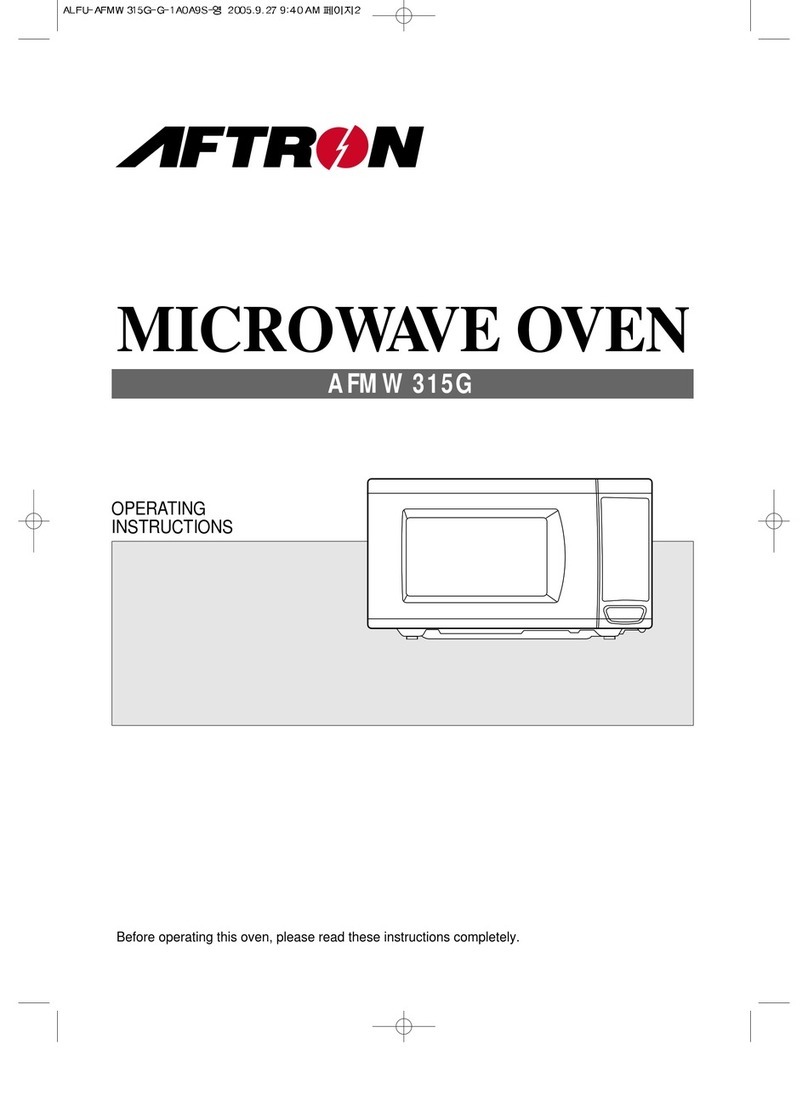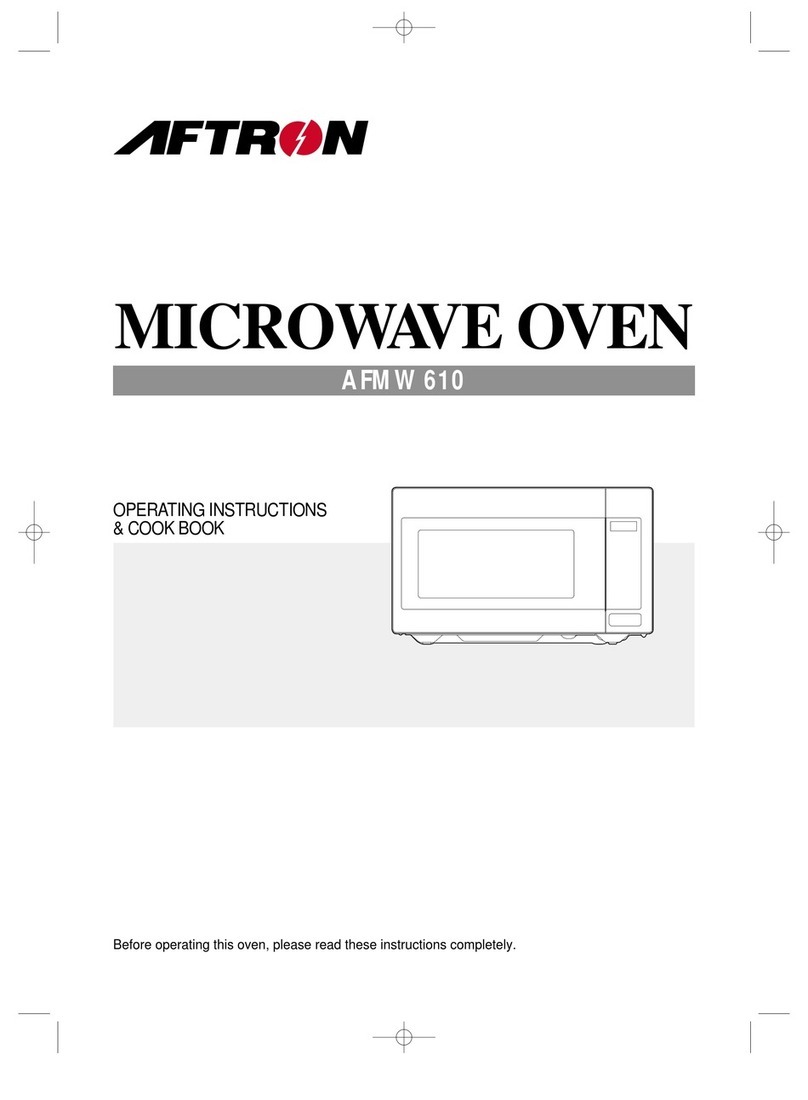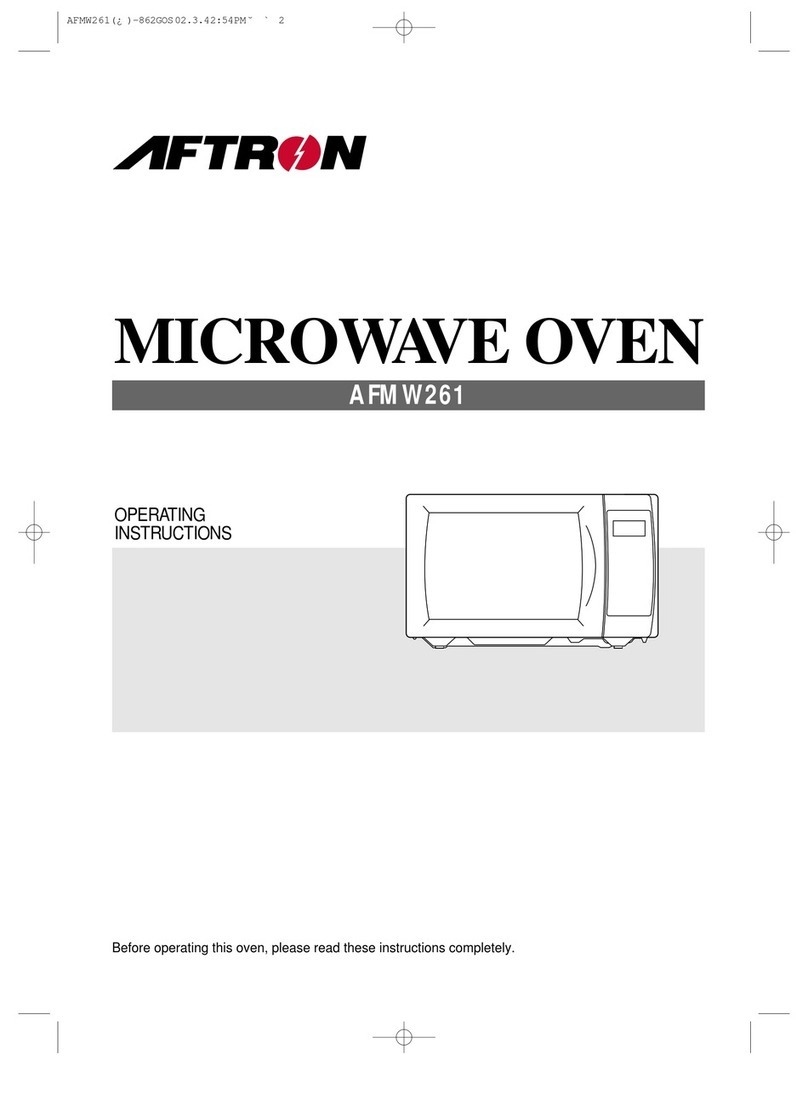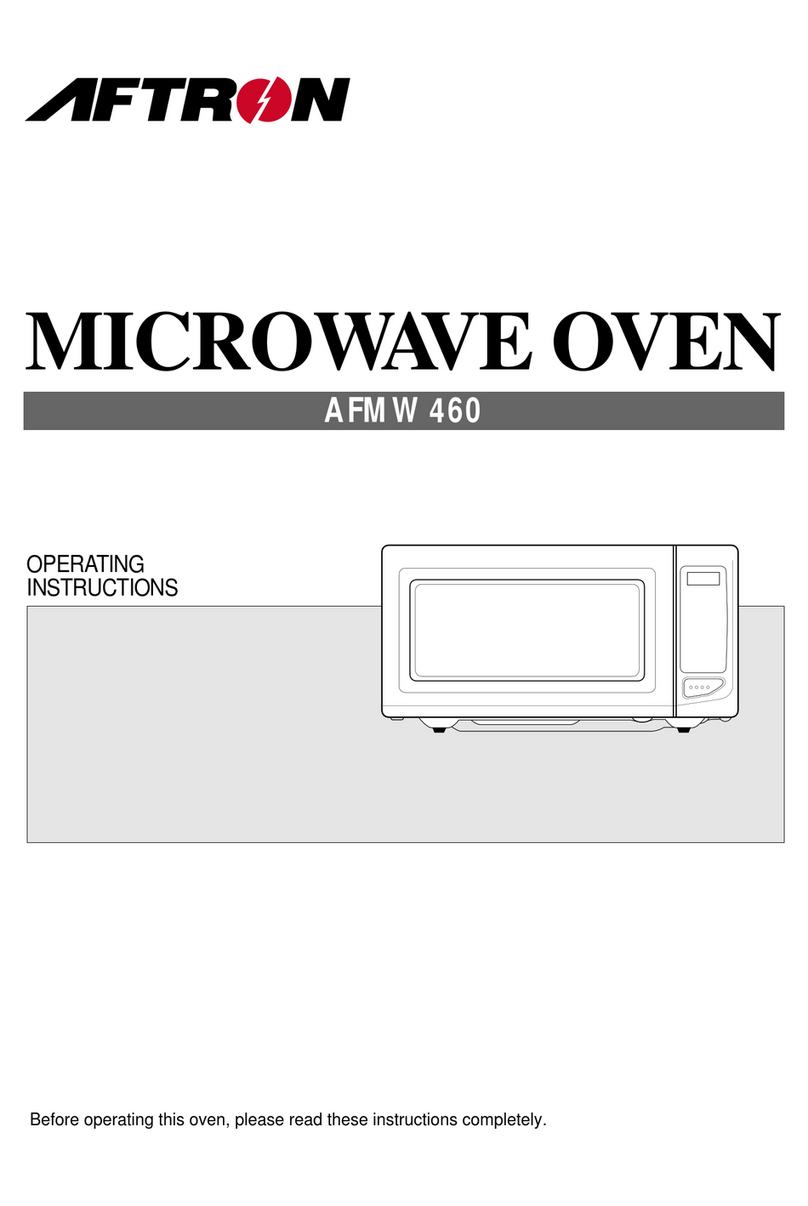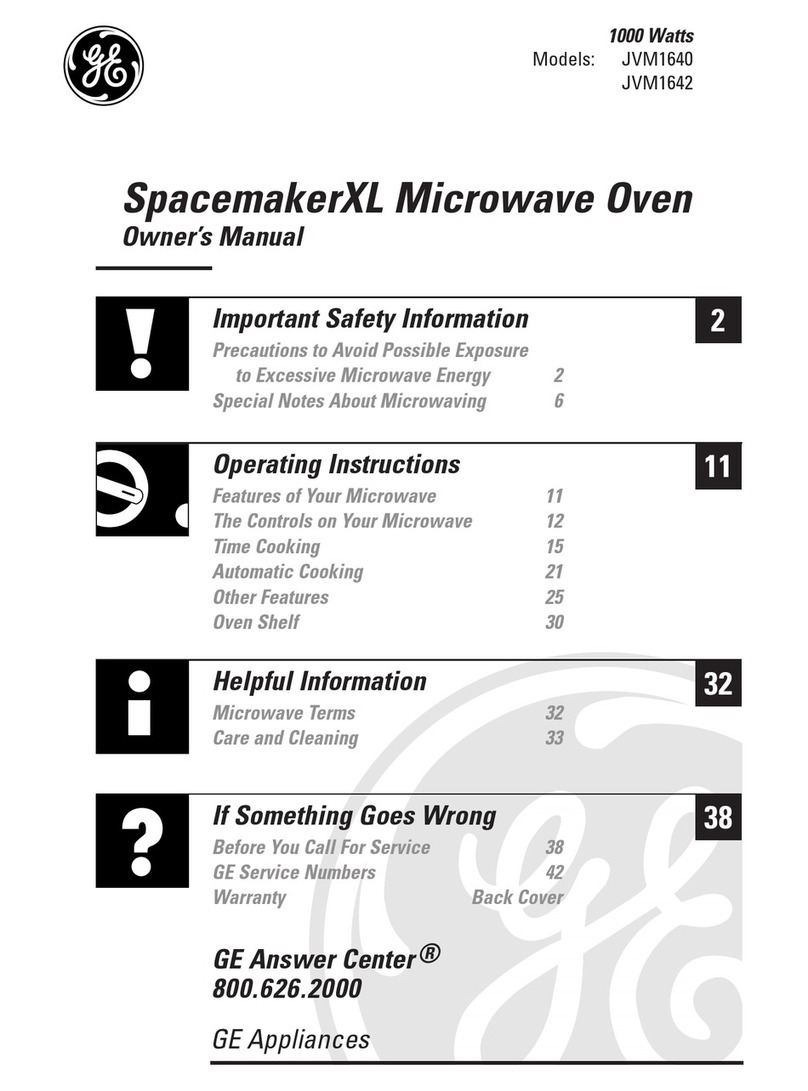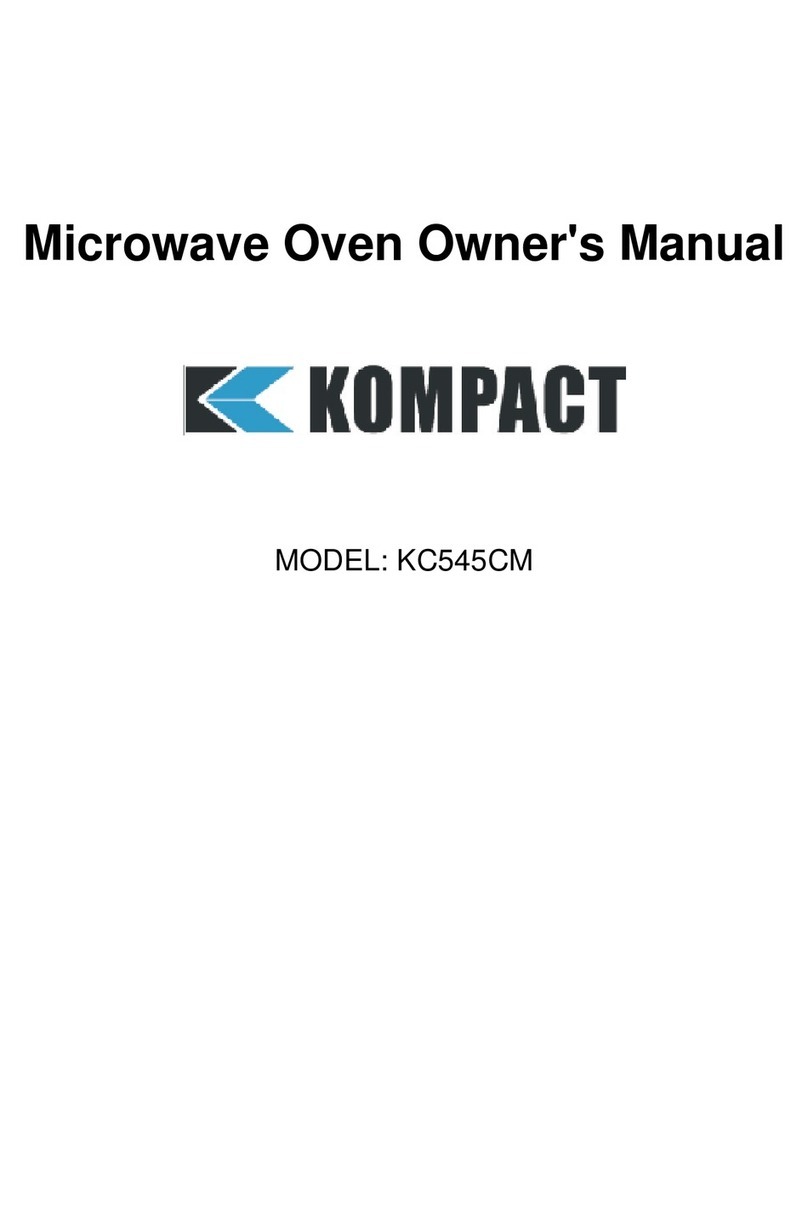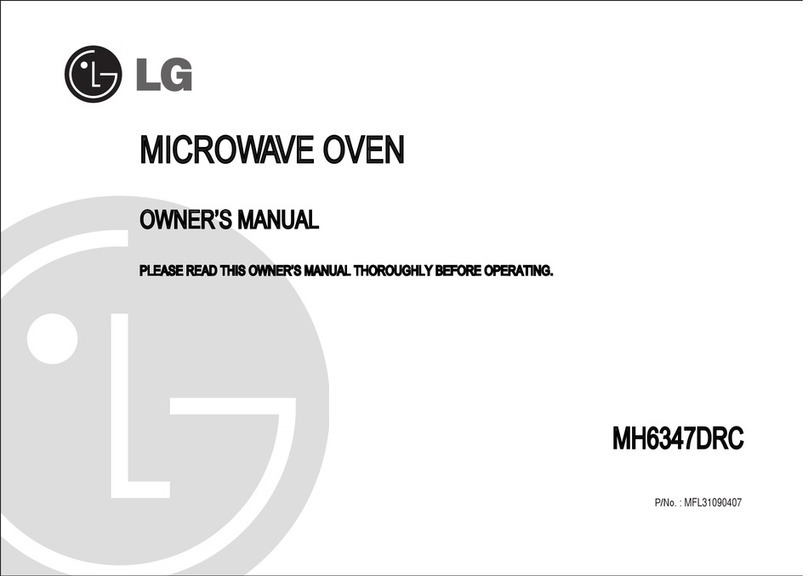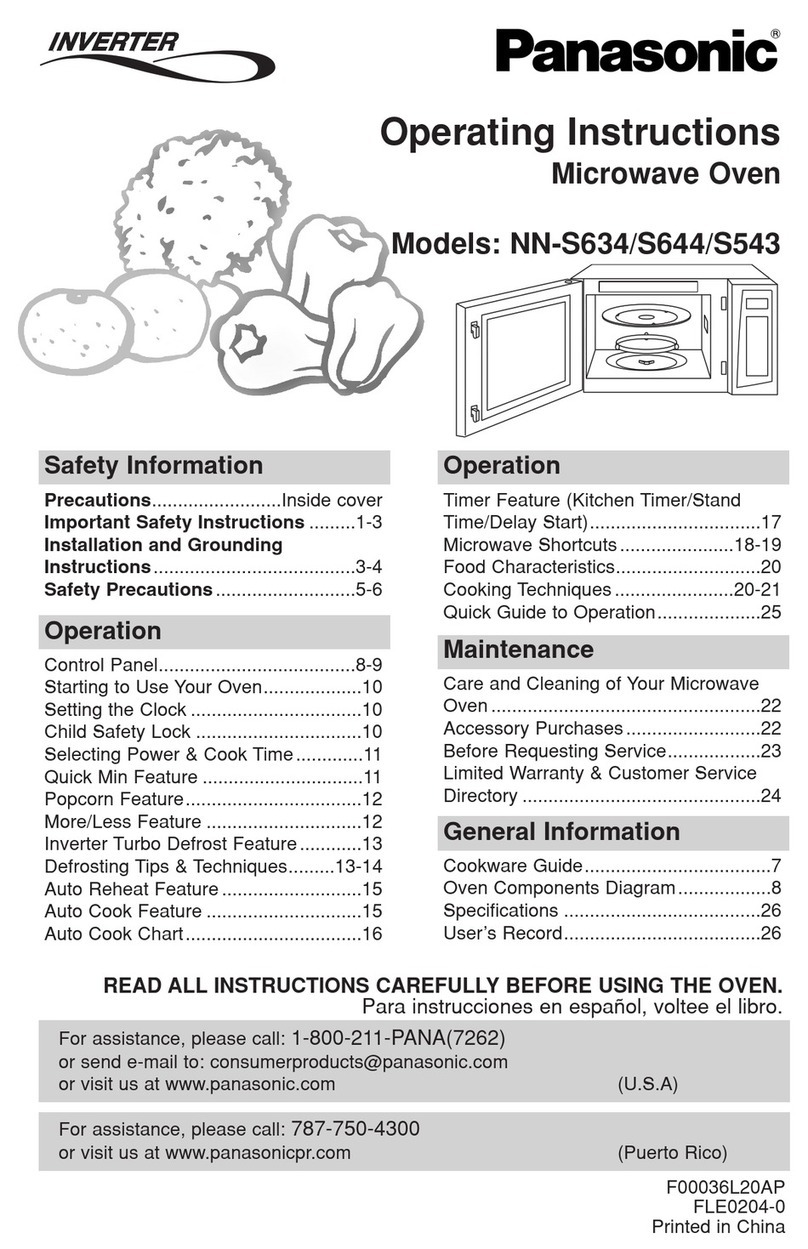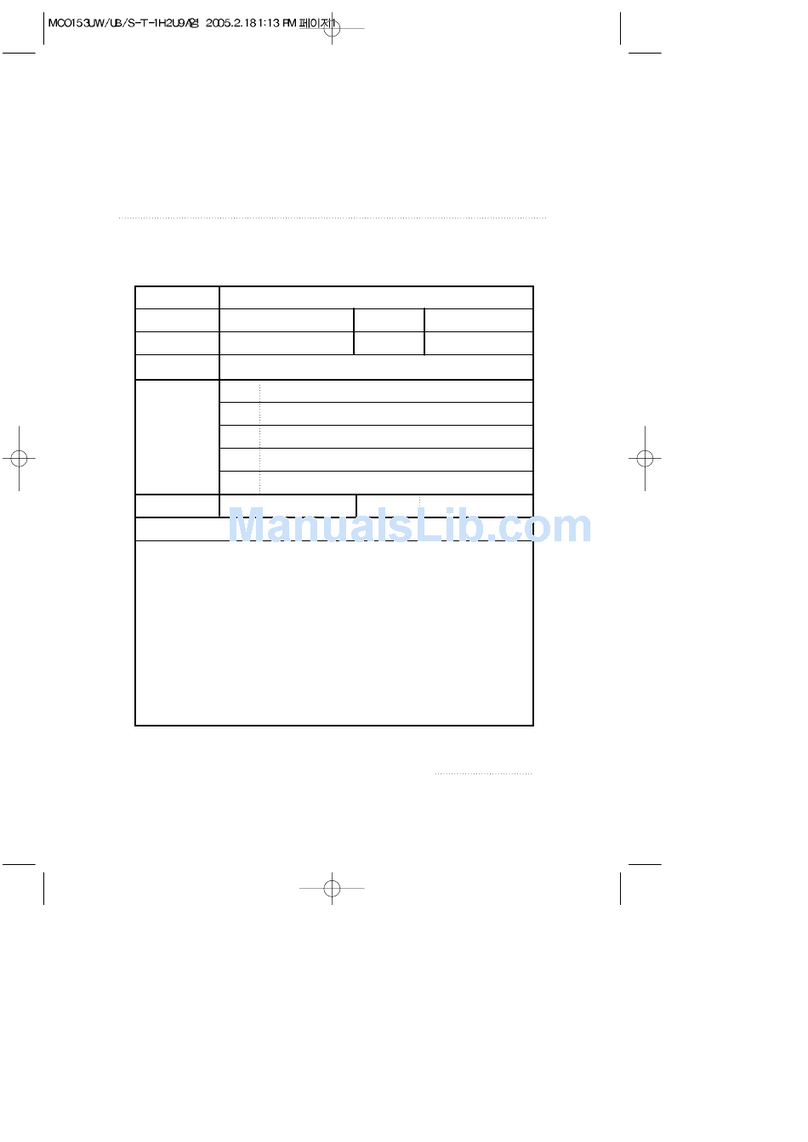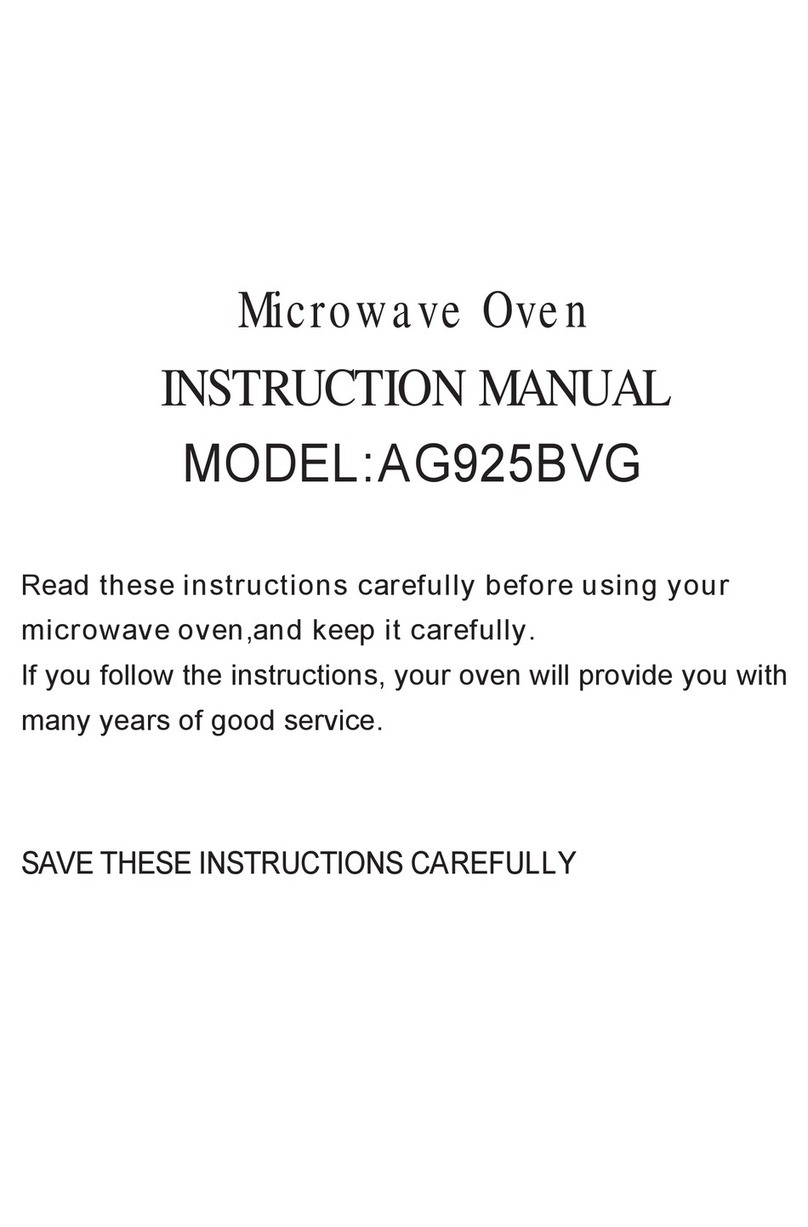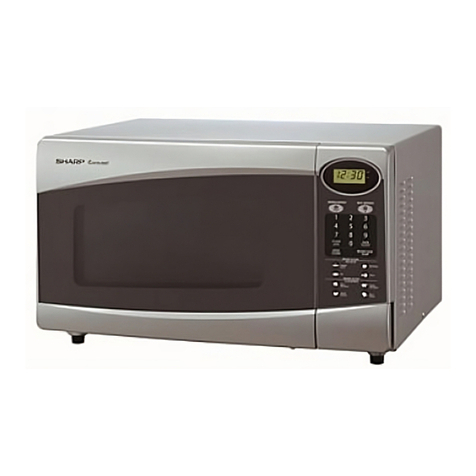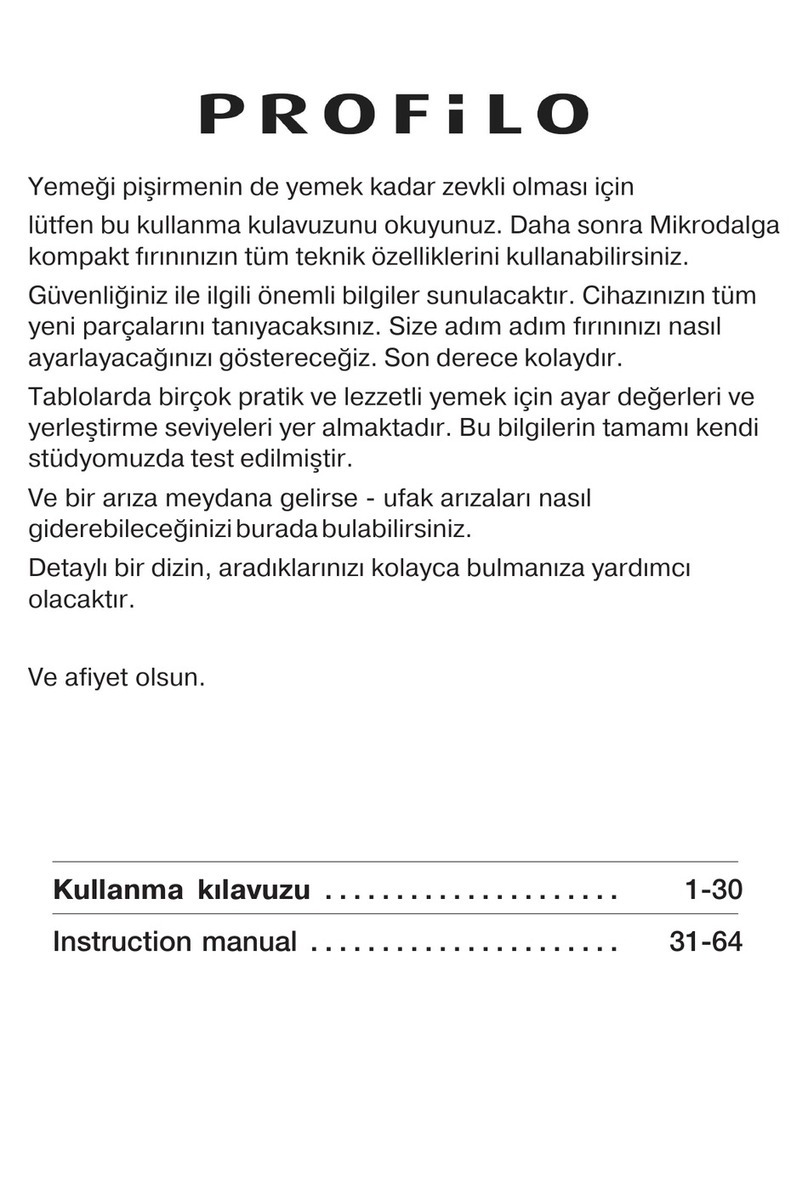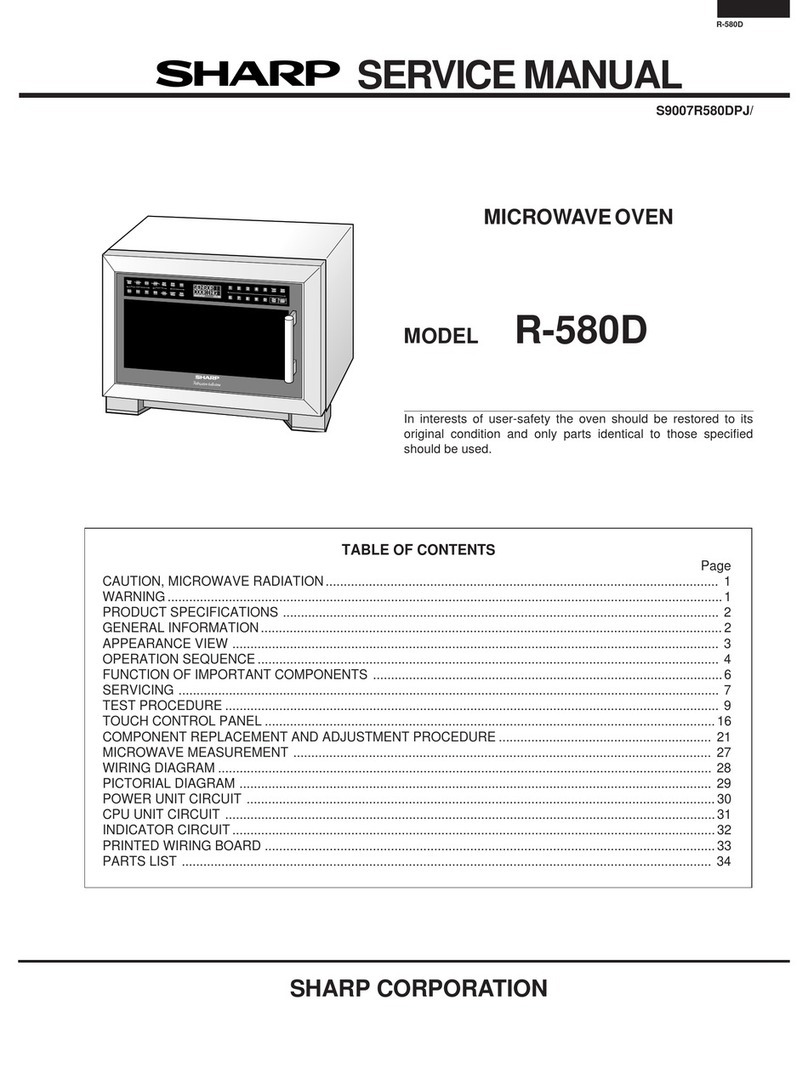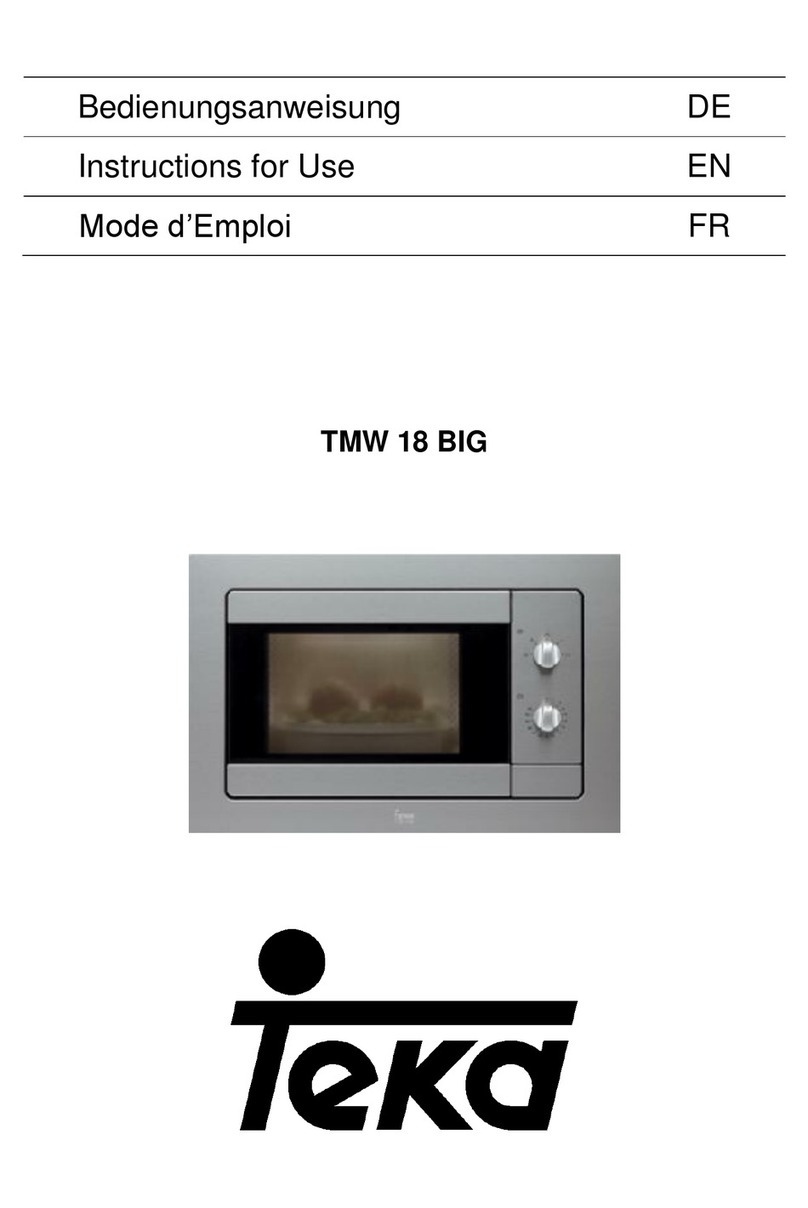Aftron AFMW200G Assembly Instructions

Before operating this oven, please read these instructions completely.
OPERATING INSTRUCTIONS
& COOK BOOK
MICROWAVE OVEN
AFMW200G

1
PRECAUTIONS TO AVOID POSSIBLE EXPOSURE TO
EXCESSIVE MICROWAVE ENERGY.........................................................................................................1
IMPORTANT SAFETY INSTRUCTIONS ....................................................................................................2
EARTHING INSTRUCTIONS.......................................................................................................................3
INSTALLATION .............................................................................................................................................3
FEATURES DIAGRAM.............................................................................................................................4~5
OPERATION PROCEDURE ........................................................................................................................6
HOW TO SET THE OVEN CONTROLS...............................................................................................7~11
HOW TO STOP THE OVEN WHILE THE OVEN IS OPERATING.........................................................12
CARE AND CLEANING..............................................................................................................................13
SPECIFICATIONS.......................................................................................................................................14
IMPORTANT NOTE....................................................................................................................................14
BEFORE YOU CALL FOR SERVICE........................................................................................................15
QUESTIONS AND ANSWERS............................................................................................................15~16
COOKING INSTRUCTIONS.......................................................................................................................17
COOKING UTENSILS.................................................................................................................................17
USE YOUR MICROWAVE OVEN SAFELY..............................................................................................18
ARCING........................................................................................................................................................18
MICROWAVING PRINCIPLES ..................................................................................................................19
HOW MICROWAVES COOK FOOD.........................................................................................................19
CONVERSION CHARTS............................................................................................................................19
COOKING TECHNIQUES..........................................................................................................................20
DEFROSTING GUIDE................................................................................................................................21
DEFROSTING CHART...............................................................................................................................22
COOKING & REHEATING CHART...........................................................................................................23
VEGETABLE CHART...........................................................................................................................24~25
RECIPES...............................................................................................................................................26~28
TABLE OF CONTENTS
PRECAUTIONS TO AVOID POSSIBLE EXPOSURE
TO EXCESSIVE MICROWAVE ENERGY
(a) Do not attempt to operate this oven with the door open since open-door operation can result in
harmful exposure to microwave energy. It is important not to defeat or tamper with the safety
interlocks.
(b) Do not place any object between the oven front face and the door or allow soil or cleaner residue
to accumulate on sealing surfaces.
(c) WARNING : If the door or door seals are damaged, the oven must not be operated until it has been
repaired by a competent person : (1) door (bent), (2) hinges and latches(broken or loosened), (3)
door seals and sealing surfaces.
(d) WARNING : It is hazardous for anyone other than a competent person to carry out any service or
repair operation which involves the removal of a cover which gives protection against exposure to
microwave energy.
(e) WARNING : Liquids or other foods must not be heated in sealed containers since they are liable to
explode.
(f) The appliance is not intended for use by young children or infirm person without supervision. Young
children should be supervised to ensure that they do not play with the appliance.
(g) WARNING : Only allow children to use the oven without supervision when adequate instructions
have been given so that the child is able to use the oven in a safe way and understands the hazards
of improper use.

2
IMPORTANT SAFETY INSTRUCTIONS
SAVE THESE INSTRUCTIONS
READ CAREFULLY AND KEEP FOR FUTURE REFERENCE.
WARNING : To prevent fire, burns, electric shock and other warnings:
Listed below are, as with all appliances, certain rules to follow and safeguards to assure high
performance from this oven:
1. Do not use the oven for any reason other than
food preparation, such as for drying clothes,
paper, or any other nonfood items or for
sterilizing purposes.
2. Do not use the oven when empty, this could
damage the oven.
3. Do not use the oven cavity for any type of
storage, such as papers, cookbook, cookware,
etc.
4. Do not operate the oven without the glass tray in
place. Be sure it is properly sitting on the rotating
base.
5. Make sure you remove caps or lids prior to
cooking when you cook food sealed in bottles.
6. Do not put foreign material between the oven
surface and door. It could result in excessive
leakage of microwave energy.
7. Do not use recycled paper products for cooking.
They may contain impurities which could cause
sparks and/or fires when used during cooking.
8. Do not pop popcorn unless popped in a
microwave approved popcorn popper or unless
it's commercially packaged and recommended
especially for microwave ovens. Microwave
popped corn produces a lower yield than
conventional popping; there will be a number of
unpopped kernels. Do not use oil unless
specified by the manufacturer.
9. Do not cook any food surrounded by a
membrane, such as egg yolks, potatoes,
chicken livers, etc., without first piercing them
several times with a fork.
10. Do not pop popcorn longer than the
manufacturer's directions. (popping time is
generally below 3 minutes). Longer cooking
does not yield more popped corn, it can cause
scorchings and fire.
Also, the cooking tray can become too hot to
handle or may break.
11. If smoke is observed, switch off or unplug the
appliance and keep the door closed in order to
stifle any flames.
12. When heating food in plastic or paper
containers, keep an eye on the oven due to the
possibility of ignition.
13. The contents of feeding bottles and baby food
jars shall be stirred or shaken and the
temperature checked before consumption, in
order to avoid burns.
14. Always test the temperature of food or drink
which has been heated in a microwave oven
before you give it to somebody, especially to
children or elderly people. This is important
because things which have been heated in a
microwave oven carry on getting hotter even
though the microwave oven cooking has
stopped.
15. Eggs in their shell and whole hard-boiled
should shall not be heated in microwave ovens
since they may explode, even after microwave
heating has ended;
16. Keep the waveguide cover clean at all times.
Wipe the oven interior with a soft damp cloth
after each use. If you leave grease or fat
anywhere in the cavity it may overheat, smoke
or even catch fire when next using the oven.
17. Never heat oil or fat for deep frying as you
cannot control the temperature and doing so
may lead to overheating and fire.
18. Microwave heating of beverages can result in
delayed eruptive boiling, therefore care must to
be taken when handling the container.
19. a) Be cautions about touching parts other than
control panel during or immediately following
grill or combi cooking.
b) Always use hot pads or oven mitts when
placing or removing food and/or accessories
from the oven.

3
EARTHING INSTRUCTIONS
This appliance must be earthed. In the event of an electrical short circuit, earthing reduces the risk of electric
shock by providing an escape wire for the electric current. This appliance is equipped with a cord having a
earthing wire with a earthing plug. The plug must be plugged into an outlet that is properly installed and earthed.
WARNING : Improper use of the earthing plug can result in a risk of electric shock. Consult a
qualified electrician or serviceman if the earthing instructions are not completely
understood, or if doubt exists as to whether the appliance is properly earthed. If it is
necessary to use an extension cord, use only a 3-wire extension cord that has a 3-
blade earthing plug, and a 3-slot receptacle that will accept the plug on the appliance.
The marked rating of the extension cord should be equal to or greater than the
electrical rating of the appliance.
INSTALLATION
1. Ventilation
Do not block air vents. If they are blocked
during operation, the oven may overheat and
eventually cause a failure. For proper
ventilation, allow above 3 inches of space
between oven sides, rear and the minimum
height of free space necesary above the top
surface of the oven is 100mm.
2. Steady, flat location
This oven should be set on a steady, flat
surface. This oven is designed for counter top
use only.
3. Leave space behind and side
All air vents should be kept a clearance. If all
vents are covered during operation, the oven
may overheat and, eventually, oven failure.
4. Away from radio and TV sets
Poor television reception and radio
interference may result if the oven is located
close to a TV, Radio antenna, feeder and so
on. Position the oven as far from them as
possible.
5. Away from heating appliance and water
taps
Keep the oven away from hot air, steam or
Splash when choosing a place to position it,
or the insulation might be adversely affected
and breakdowns occur.
6. Power supply
• Check your locla power source. This oven
requires a current of approximately 11
amperes, 220~240V 50Hz.
• Power supply cord is about 0.8 meters long.
• The voltage used must be the same as
specified on this oven. Using a higher
voltage may result in a fire or other accident
causing oven damage. Using low voltage
will cause slow cooking. We are not
responsible for damage resulting from use
of this oven with a voltage of ampere fuse
other than those specified.
• If the supply cord is damaged, it must be
replaced by the manufacturer or its service
agent or a similarly qualified person in order
to avoid a hazard.
7. Examine the oven after unpacking for any
damage such as:
A misaligned door, Broken door, A dent in
cavity. If any of the above are visible, DO
NOT INSTALL, and notify dealer immediately.
8. Do not operate the oven if it is colder than
room temperature.
(This may occur during delivery in cold
weather.) Allow the oven to become room
temperature before operating.

4
11Door seal - Door seal maintains the
microwave energy within the oven cavity and
prevents microwave leakage.
22Reflector (Insulator Heater)
33Heating Element
44Oven cavity
55Safety interlock system
66Metal Rack
77Coupler - This fits over the shaft in the
center of the ovens cavity floor. This is to
remain in the oven for all cooking.
88Roller guide - This must always be used for
cooking together with the glass cooking tray.
99Glass cooking tray - Made of special heat
resistant glass. Food in a proper receptacle
is placed on this tray for cooking.
00Door viewing screen - Allows viewing of
food. The screen is designed so that light
can pass through, but not the microwave.
qqDoor hook - When the door is closed, it will
automatically shut off. If the door is opened
while the oven is operating, the magnetron
will immediately stop operating.
FEATURES DIAGRAM
12345
6
q09 8 7

5
11Display - Cooking time, power level,
indicators and present time are displayed.
22Auto cook - Used to cook using a program
or to reheat.
33Power/Def. - Used to set power level. Used
to defrost foods by weight or time.
44Grill/Combi - Used to cook grill/combi.
55Clock - Used to set clock.
66Start/Express cook - Used to start the oven
operation and also increase the reheat time
by 30 seconds.
77Dial knob - Used to set the time and weight.
88Stop/Clear - Used to stop the oven
operation or to erase all entries.
FEATURES DIAGRAM (continued)
8
5
3
1
4
2
7
6

6
OPERATION PROCEDURE
This section includes useful information about oven operation.
a. Plug power supply cord into a 220~240V 50Hz power outlet.
b. After placing the food in a suitable container, open the oven door and put it on the glass tray.
The glass tray and roller guide must always be in place during cooking.
c. Shut the door. Make sure that it is firmly closed.
WATTAGE OUTPUT CHART
• The power-level is set by pressing the Power/Def. button. The chart shows the display, the power
level and the percentage of power.
The oven light is on only when the microwave
oven is operating.
The oven door can be opened at any time during
operation by touching the door release button on
the control panel. The oven will automatically
shut off.
Each time a button is touched, a BEEP will
sound to acknowledge the touch.
The oven automatically cooks on full power
unless set to a lower power level.
The display will show “ : 0” when the oven is
plugged in.
Time clock returns to the present time when the
cooking time ends.
When the STOP/CLEAR button is touched
during the oven operation, the oven stops
cooking and all information retained. To erase all
information(except the present time), touch the
STOP/CLEAR button once more.
If the oven door is opened during the oven
operation, all information is retained.
If the START button is touched and the oven
does not operate, check the area between the
door and door seal for obstructions and make
sure the door is closed securely.
The oven will not start cooking until the door is
completely closed or the program has been
reset.
NOTE : When using the GRILL or COMBI mode;
• Do not open the door so often, the temperature
inside the oven decrease and the cooking may
not be completed in setting time.
• Never touch the oven window and metal
interior of the oven when taking food in and out,
because the temperature inside the oven and
door is very high.
• When using these modes, be careful as the
tray will be hot to touch, use oven gloves or pot
holders while handling tray.
1
2
3
4
5
6
7
8
9
Make sure the oven is properly installed
and plugged into the electrical outlet.
Touch Power pad Power level (Display)
Approximate Percentage of Power
once P-HI 100%
twice P-80 80%
3 times P-60 60%
4 times P-40 40%
5 times P-20 20%

7
CONTROLS
SETTING THE CLOCK
When the oven is first plugged in, the display will flash “ :0” and a tone will sound. If the AC power
ever turns off, the display shows “ :0” when the power comes back on.
1. Press Clock button.
This is a 12 hour clock system.
2. Press Clock button once more.
This is a 24 hour clock system.
4. Press Clock button.
5. Turn the dial knob to adjust minute.
6. Press Clock button.
3. Turn the dial knob to adjust hour.
If you selected 12 hour system, the display
will show the hours from “1” to “12”.
If you selected 24 hour system, the display
will show the hours from “0” to “23”.
The adjusted hour starts blinking.
The minute stops blinking and “00” starts
blinking.
The display will show the minutes from “0” to
“59”. The adjusted minute starts blinking.
NOTE : This oven has multiple clock
systems. If you want 12 hour
clock system, omit this step.
Clock
Clock
Clock
When you press Clock button, the minute stops blinking, and the colon starts blinking. If you selected 12
hour clock system, this digital clock allows you to set from 1:00 to 12:59. If you selected 24 hour clock
system, this digital clock allows you to set from 0:00 to 23:59.

TIME DEFROSTING
When TIME DEFROST is selected, the automatic cycle divides the defrosting time into periods of
alternating defrost and stand times by cycling on and off.
1. Press Power/Def. button.
2. Turn the dial knob to adjust the defrosting time.
3. Press Start button.
The DEF. indicator appears and “ : 0” is
displayed.
The display will show what you selected.
Power/Def.
Start
When you press Start button, the DEF. indicator starts blinking to show the oven is the DEFROST mode.
The display counts down the time to show you how much defrosting time is left in the DEFROST mode.
The oven beeps during the defrosting cycle to signal that the food needs to be turned or rearranged.
When the defrosting time ends, you will hear 3 beeps.
X 7
NOTE: Your oven can be programmed
for 59 miutes 00 seconds. (59:00)
8
WEIGHT DEFROSTING
WEIGHT DEFROST lets you easily defrost food by eliminating guesswork in determining defrosting
time. The minimum weight for WEIGHT DEFROST is 200 gram and the maximum weight is 3,000
gram. Follow the steps below for easy defrosting.
1. Press Power/Def. button.
2. Turn the dial knob to adjust the defrosting weight.
3. Press Start button.
The DEF. indicator & “0” appear and the g
indicator starts blinking.
The display will show what you selected.
Power/Def.
Start
When you press Start button, the g indicator disappears and the DEF. indicator starts blinking to show
the oven is in the DEFROST mode. The display counts down the time to show you how much
defrosting time is left in the DEFROST mode. The oven beeps during the defrosting cycle to signal that
the food needs to be turned or rearranged. When the defrosting time ends, you will hear 3 beeps.
X 6

9
COOKING IN ONE STAGE
When you press Start pad, the M/W indicator starts blinking to show the oven is cooking.
The display counts down the time to show how much cooking time is left. When the cooking time ends, you
will hear 3 beeps.
1. Press Power button.
(Select the desired power
level.)
X 3
2. Turn the dial knob to adjust the cooking time.
3. Press Start button.
The M/W indicator appears and the display
will show what you selected.
This example shows power level 6.
The display will show what you selected.
NOTE: Using lower power levels increases the cooking time which is recommended for foods such
as cheese, milk and slow cooking of meats.
NOTE: If step 1 is omitted, the oven will
cook at full power.
NOTE: Your oven can be programmed
for 59 minutes 00 seconds.(59:00)
Power
Start

10
GRILL COOKING
This function allow you to brown food quickly. The heating element is located in the top of the oven.
There is no pre-heating the oven for grill cooking. Place food inside the oven when setting the
controls.
When you press Start button, the Grill indicator starts blinking to show the oven is cooking.
The display counts down the time to show how much cooking time is left. When the cooking time ends, you
will hear 3 beeps.
1. Press Grill/Combi button.
2. Turn the dial knob to adjust the cooking time.
3. Press Start button.
The Grill indicator lights and “ : 0” is displayed.
The display will show what you touched.
Grill/Combi
NOTE: Time can be set up to 30
minutes.
COMBI COOKING
The oven has combination mode which cooks food with heater and microwave at the same time.
The combination mode accelerates the cooking process.
When you press Start button, the Combi indicator starts blinking to show the oven is cooking.
The display counts down the time to show how much cooking time is left. When the cooking time ends, you
will hear 3 beeps.
1. Press Grill/Combi button.
2. Press Grill/Combi button once more.
3. Turn the dial knob to adjust the cooking time.
4. Press Start button.
The Grill indicator lights and “ : 0” is displayed.
The Combi indicator lights and “ : 0” is
displayed.
The display will show what you touched.
Grill/Combi
NOTE: Time can be set up to 59 minutes
00 seconds. (59:00)

11
1. Press Auto cook button.
2. Turn the DIAL KNOB to adjust the desired quantity.
3. Press Start button.
When you press AUTO COOK button once,
“AC-1” is displayed. By repeatedly pressing
this button, you can select one of the four
menu programs as shown in the chart below.
The display will show what you selected.
When you press Start button, the display
changed into cooking time and the oven starts
cooking.
When the cooking time ends, you will hear 3
beeps.
Directions
Put foods on the microwave plate and cover with
vented plastic wrap.
Pour soup in microwave bowl or mug.
Stir before serving.
Pour beverage in microwave mug and place it on the
turntable. Do not cover.
Stir before serving.
Wash and put in casserole. Add no water if
vegetables have just been washed. Cover tender
vegetables with lid and stir after cooking.
AUTO COOK
AUTO COOK allows you to cook or reheat many of your favorite foods by repeatedly touching Auto cook
button.
Auto cook
Start
Food
Dinner Plate
Soup
Beverage
Fresh
vegetable
Press Autocook
button
once
twice
three times
four times
Display
AC-1
AC-2
AC-3
AC-4
Weight
350g
450g
350g
450g
1 CUP (200ml)
2 CUPS (200mlx2)
3 CUPS (200mlx3)
200g
400g
EXPRESS COOKING
EXPRESS COOK allows you to reheat for 30 seconds at 100% (full power) by simply pressing the
Express cook button.
By repeatedly pressing the Easy cook button, you can also extend reheating time to 5 minutes by 30
seconds.
1. Press Express cook button.
When you press Express cook button, ":30"
appears. The oven starts reheating.
When the cooking time ends, you will hear 3
beeps.
Express
cook

12
CHILD SAFETY LOCK
The safety lock prevents unwanted oven operation such as by small children.
To set, press and hold Stop/Clear for 3 seconds, and a beep sounds. Each time a pad(except Stop/Clear)
is touched, “LOC” is displayed.
To cancel, press and hold Stop/Clear for 3 seconds, and a beep sounds.
TO STOP THE OVEN WHILE THE OVEN IS OPERATING
1. Press Stop/Clear button.
• You can restart the oven by pressing Start button.
• Press Stop/Clear button once more to erase all instructions.
• You must enter in new instructions.
2. Open the door.
• You can restart the oven by closing the door and pressing Start button.
NOTE: Oven stops operating when door is opened.

13
CARE AND CLEANING
Although your oven is provided with safety features, it is important to observe the following:
1.It is important not to defeat or tamper with safety interlocks.
2.Do not place any object between the oven front face and the door or allow residue to accumulate on
sealing surfaces. Wipe the sealing area frequently with a mild detergent, rinse and dry. Never use
abrasive powders or pads.
3.When opened, the door must not be subjected to strain, for example, a child hanging on an opened
door or any load could cause the oven to fall forward to cause injury and also damage to the door.
Do not operate the oven if it is damaged, until it has been repaired by a competent service
technician. It is particularly important that the oven closes properly and that there is no damage to
the:
i) Door(bent)
ii) Hinges and Hookes(broken or loosened)
iii) Door seals and sealing surfaces.
4.The oven should not be adjusted or repaired by anyone except a properly competent service
technician.
5.The oven should be cleaned regularly and any food deposits removed;
6.Failure to maintain the oven in a clean condition could lead to deterioration of the surface that could
adversely affect the life of the appliance and possibly result in a hazardous situation.

14
IMPORTANT
The wires in this mains lead are coloured in accordance with the following code.
Green-and-yellow : Earth
Blue : Neutral
Brown : Live
As the colours of the wires in the mains lead of this appliance may not correspond with the
coloured markings identifying the terminals in your plug, proceed as follows:
The wire which is coloured green-and-yellow must be connected to the terminal in the plug which
is marked with the letter ‘E’ or by the earth symbol or green-and-yellow. The wire which is
coloured blue must be connected to the terminal which is marked with the letter 'N' or coloured
black.
The wire which is coloured brown must be connected to the terminal which is marked with the
letter ‘L’ or coloured red.
WARNING: This appliance must be earthed.
POWER SUPPLY 220~240V 50Hz, SINGLE PHASE WITH EARTHING
POWER MICROWAVE 1200 W
CONSUMPTION GRILL 1050 W
COMBINATION 2200 W
MICROWAVE ENERGY OUTPUT 800W
MICROWAVE FREQUENCY 2450MHz
OUTSIDE DIMENSIONS (WXHXD) 465 x 279 x 360mm
CAVITY DIMENSIONS (WXHXD) 290 x 220 x 306mm
NET WEIGHT APPROX. 13.7Kg
TIMER 59 min. 00 sec.
POWER SELECTIONS 5 LEVELS
CAVITY VOLUME 0.7 Cu.Ft.
* Specifications are subject to change without notice.
SPECIFICATIONS

15
BEFORE YOU CALL FOR SERVICE
Refer to following checklist, you may prevent an unnecessary service call.
* The oven doesn’t work :
1. Check that the power cord is securely plugged in.
2. Check that the door is firmly closed.
3. Check that the cooking time is set.
4. Check for a blown circuit fuse or tripped main circuit breaker in your house.
* Sparking in the cavity;
1. Check utensils. Metal containers or dishes with metal trim should not be used.
2. Check that metal skewers or foil does not touch the interior walls.
If there is still a problem, contact the service station.
A list of these stations is included in the oven.
QUESTIONS AND ANSWERS
* Q : I accidentally ran my microwave oven without any food in it. Is it damaged?
*A : Running the oven empty for a short time will not damage the oven. However, it is not
recommended.
* Q : Can the oven be used with the glass tray or roller guide removed?
*A : No. Both the glass tray and roller guide must always be used in the oven before cooking.
* Q : Can I open the door when the oven is operating?
*A : The door can be opened anytime during the cooking operation. Then microwave energy will be
instantly switched off and the time setting will maintain until the door is closed.
* Q : Why do I have moisture in my microwave oven after cooking?
*A : The moisture on the side of your microwave oven is normal. It is caused by steam from cooking
food hitting the cool oven surface.
* Q : Does microwave energy pass through the viewing screen in the door?
*A : No. The metal screen bounces back the energy to the oven cavity. The holes are made to allow
light to pass through. They do not let microwave energy pass through.
* Q : Why do eggs sometimes pop?
*A : When baking or poaching eggs, the yolk may pop due to steam build-up inside the yolk
membrane. To prevent this, simply pierce the yolk with a toothpick before cooking. Never cook
eggs without piercing their shells.
DO NOT ATTEMPT TO SERVICE THE OVEN YOURSELF !

QUESTIONS AND ANSWERS (continued)
* Q : Why this standing time recommended after the cooking operation has been completed?
*A : Standing time is very important.
With microwave cooking, the heat is in the food, not in the oven. Many foods build up enough
internal heat to allow the cooking process to continue, even after the food is removed from the
oven. Standing time for joints of meat, large vegetables and cakes is to allow the inside to cook
completely, without overcooking the outside.
* Q : What does “standing time” mean?
*A : “Standing time” means that food should be removed from the oven and covered for additional
time to allow it to finish cooking. This frees the oven for other cooking.
* Q : Why does my oven not always cook as fast as the microwave cooking guide says?
*A : Check your cooking guide again, to make sure you’ve followed directions exactly ; and to see
what might cause variations in cooking time. Cooking guide times and heat settings are
suggestions, to help prevent over-cooking... the most common problem in getting used to a
microwave oven.
Variations in the size, shape and weights and dimensions could require longer cooking time. Use
your own judgement along with the cooking guide suggestions to check whether the food has
been properly cooked just as you would do with a conventional cooker.
* Q : Will the microwave oven be damaged if it operates while empty?
*A : Yes. Never run it empty.
* Q : Can I operate my microwave oven without the turntable or turn the turntable over to hold a
large dish?
*A : No. If you remove or turn over the turntable, you will get poor cooking results. Dishes used in your
oven must fit on the turntable.
* Q : Is it normal for the turntable to turn in either direction?
*A : Yes. The turntable rotates clockwise or counterclockwise, depending on the rotation of the motor
when the cooking cycle begins.
* Q : Can I pop popcorn in my microwave oven? How do I get the best results?
*A : Yes. Pop packaged microwave popcorn following manufacture’s guidelines. Do not use regular
paper bags. Use the “listening test” by stopping the oven as soon as the popping slows to a “pop”
every 1 or 2 seconds. Do not repop unpopped kernels. Do not pop popcorn in glass cookware.
16

17
COOKING UTENSILS
COOKING INSTRUCTIONS
Utensils should be checked to ensure that they are suitable for use in microwave ovens.
UTENSILS TEST
Place the utensil in question next to a glass measure filled with water, in the microwave oven. Microwave at
high power for 1-2 minutes. If the water heats up, but the utensil remains cool, the utensil is microwave-safe.
However if the utensil becomes warm, microwaves are being absorbed by the utensil and it should not be in the
microwave oven. You probably have many items on hand in your kitchen right now that can be used as cooking
equipment in your microwave oven. Read through the following checklist.
Microwave function only
Utensils and cooking containers used in a microwave
oven should be of a material that does not act as a barrier
to microwave energy. Generally this means that you
should cook in either (paper), plastic, glass or ceramic.
Metal pans reflect microwave energy and inhibit cooking,
and should not be used. In addition to material, the shape
of the container should also be considered. Round oval
shapes give the most even cooking. Square or
rectangular containers may over-cook foods in the corners
because more energy is absorbed there.
Shallow containers give more even cooking results.
Utensils made of china and ceramic excellent to use in
your microwave oven. Most types of glass are also very
good. Lead crystal glass can crack and should therefore,
not be used. Plastics and paper can also be used,
provided they can withstand the temperature of the
heated food. For cooking only use plastics, which will
withstand a temperature of over 120˚C, e.g. polypropene
and polyamide. Some plastic materials, e.g. melamine,
will be heated by the microwave, and be damaged. To
find out if a certain container is suitable, the following
simple test can be made:
Place the empty container and a glass of water inside the
microwave oven. The water is needed because the oven
must not be operated empty or with empty containers
only. Let the oven work on full power for one minute. A
suitable container will only be lukewarm.
Metal containers, e.g. saucepans or frying pans should
not be used in microwave ovens. Nor should plates or
vessels with decorations be used since metal e.g. gold,
might be part of the decoration and such decorations will
be damaged. Small pieces of aluminiuum foil can be
used, but only to shield the areas that
would over-cook (e.g. for covering
chicken wings, leg tips and fish tails)
but the foil must not touch the side of
the oven as damage may occur.
Glass (general) No Yes (1) No
Glass (heat resistant) Yes Yes Yes
Glass-ceramic and
ceramic (heat resistant) Yes Yes (1) Yes (1)
Earthenware Yes Yes Yes
China (heat resistant) Yes Yes Yes
Plastic (general) No Yes (2) No
Plastic (heat resistant) Yes (2) Yes (2) Yes (2)
Aluminium foil containers
/aluminium foil Yes Yes (3) Yes
Metal baking tins Yes (4) No Yes (4)
Metal (pots.pans, etc) Yes No No
Paper No Yes (5) No
1. Without metal parts or metal trims.
2. Some plastics are heat-proof only to certain
temperatures. Check carefully!
3. It is possible to use aluminium foil to shield deliate
areas of food (this prevents over-cooking).
4. Metal tins can be used in the combination methods,
however if these are very deep, they will greatly
reduce the efficiency, as metal shields the
microwave energy from the food.
5. Use for short term heating and covering ; they
absorb excess misture when warming food. Pay
special attention as over-heating may cause a fire in
your oven. Do not use re-cycled paper products, e.g.
kitchen rool unless they say they are specifically
designed for use in a microwave oven.
These products contain impuities which may cause
sparks and/or fires when use.
Caution:
• There are a number of accessories available on the
market. Before you buy, make sure they are suitable for
microwave use.
• When you put food in the microwave oven, make sure
that food, food supports or covering do not come in
direct contact with any of the internal walls or the ceiling
of the cavity since discolouration may take place.
Before use, the user should check that utensils are suitable for use in microwave ovens.
Material
Grill
cooking
Microwave
cooking
Combined
cooking

18
USE YOUR MICROWAVE OVEN SAFELY
General Use
Do not attempt to defeat or tamper with safety interlocks.
Do not place any object between the oven front frame and the door or allow residue to build up on sealing
surfaces. Wipe with a mild detergent, rinse and dry. Never use abrasive powders or pads.
Do not subject the oven door to strain or weight such as a child hanging on an open door.
This could cause the oven to fall forward resulting in injury to you and damage to the oven.
Do not operate the oven if door seals or sealing surfaces are damaged; or if door is bent; or if hinges are
loose or broken.
Do not operate the oven empty. This will damage the oven.
Do not attempt to dry clothes, newspapers or other materials in the oven. They may catch on fire.
Do not use recycled paper products as they may contain impurities which may cause sparks or fires.
Do not hit or strike the control panel with hard objects. This can damage the oven.
Food
Never use your microwave oven for home canning. The oven is not designed for proper home canning.
Improperly canned food may spoil and be dangerous to consume.
Always use the minimum recipe cooking time. It is better to undercook rather than overcook foods.
Undercooked foods can be returned to the oven for more cooking. If food is overcooked, nothing can be
done.
Heat small quantities of food or foods with low moisture carefully. These can quickly dry out, burn or catch
on fire.
Do not heat eggs in the shell. Pressure may build up and eggs can explode.
Potatoes, apples, egg yolks and sausages are examples of food with non-porous skins.
These must be pierced before cooking to prevent bursting.
Do not attempt to deep fat fry in your microwave oven.
Always stir liquids before heating. Heated liquids can erupt, if not mixed with air.
Do not leave the oven unattended while popping corn.
Do not pop corn in a paper bag unless it is the commercially prepared Microwave Popcorn product. The
kernels can overheat and ignite a brown paper bag.
Do not put packaged Microwave Popcorn bags directly on the oven tray. Place the package on a
microwave safe glass or ceramic plate to avoid overheating and cracking the oven tray.
Do not exceed the Microwave Popcorn manufacturers suggested popping time.
Longer popping does not yield more popcorn but it can result in scorch, burn of fire. Remember, the
Popcorn bag and tray can be too hot to handle. Remove with caution and use pot holders.
ARCING
If you see arcing, press STOP/CLEAR button and correct the problem.
Arcing is the microwave term for sparks in the oven.
Arcing is caused by:
• Metal or foil touching the side of the oven.
• Foil not molded to food (upturned edges act like antennas).
• Metal, such as twist-ties, poultry pins, or gold rimmed dishes, in the microwave.
• Recycled paper towels containing small metal pieces being used in the microwave.

19
MICROWAVING PRINCIPLES
Microwave energy has been used in this country to cook and reheat food since early experiments with
RADAR in World War ll. Microwaves are present in the atmosphere all the time, both naturally and
manmade sources. Manmade sources include radar, radio, television, telecommunication links and car
phones.
CONVERSION CHARTS
In a microwave oven,
electricity is
converted into
microwave by the
MAGNETRON.
REFLECTION The microwaves
bounce off the metal
walls and the metal
door screen.
TRANSMISSION Then they pass through
the cooking containers to
be absorbed by the water
molecules in the food, all
foods contain water to a
more or lesser extent.
ABSORPTION
The microwaves cause the water molecules to
vibrate which causes FRICTION, i.e. HEAT. This
heat then cooks the food. Microwaves are also
attracted to fat and sugar particles, and foods high
in these will cook more quickly. Microwaves can
only penetrate to a depth of 11/2 - 2 inches(4-5cm)
and as heat spreads through the food by
conduction, just as in a traditional oven, the food
cooks from the outside inwards.
WEIGHT MEASURES
15 g 1/2oz.
25 g 1 oz.
50 g 2 oz.
100 g 4 oz.
175 g 6 oz.
225 g 8 oz.
450 g 1 lb.
HOW MICROWAVES COOK FOOD
▲
▲▲
VOLUME MEASURES
30 ml 1 fl.oz.
100 ml 3 fl.oz.
150 ml 5 fl.oz. (1/4 pt)
300 ml 10 fl.oz. (1/2 pt)
600 ml 20 fl.oz. (1pt)
SPOON MEASURES
1.25 ml 1/4tsp
2.5 ml 1/2tsp
5 ml 1 tsp
15 ml 1 tbsp
FLUID MEASUREMENTS
1 Cup = 8 fl.oz. = 240 ml
1 Pint = 16 fl.oz. (UK 20 fl.oz.) = 480 ml (UK 560 ml)
1 Quart = 32 fl.oz. (UK 40 fl.oz.) = 960 ml (UK 1120 ml)
1 Gallon = 128 fl.oz. (UK 160 fl.oz.) = 3840 ml (UK 4500 ml)
Table of contents
Other Aftron Microwave Oven manuals
